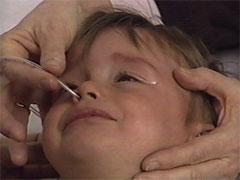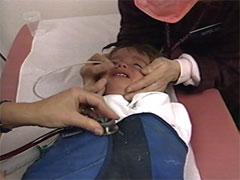A) Moisten the tube in the child's mouth to avoid bacteriostatic lubricants.

B) Place NG tube into child's nose - stay away from the septum and aim directly perpendicular to the bed as you advance the tube.

C) Pass the tube into child's throat.
(If the child does not swallow the tube, take a breath, pull your mask away, puff in the child's face and replace your mask. This maneuver frequently elicits a swallow - look to make sure that the tube is not coiled in the mouth. Children frequently vomit at this stage, so be prepared to collect any emesis in a specimen cup. It may contain the mucous we're looking for.)

D) Once the child swallows the tube, pass the tube quickly down into stomach. Stop when the pen mark on the tube reaches the tip of the nose.
RARELY, the tube will pass into the airway rather than into the stomach. If the child has any respiratory distress or a muffled cry, the tube is passing between the vocal cords. Remove the tube immediately.
Successful tube placement is suggested by a strong unchanged cry, gastric contents in the tube, strong gurgling sound ascultated over stomach when air is injected into the tube via syringe.